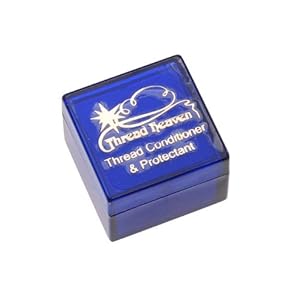I am totally not a gadget person and don't fall for a lot of the crazy notions out there one can purchase for sewing. There are sooooo many and if we tried them all we'd go broke. And more than half the time, there's no need for the gadget because the job can be done just as well with something common place you already have. (I have never crocheted in my life, but you can find a huge assortment of crochet hooks in my studio because they make the best pokers when turning something skinny right side out!)
That said - there is still a nice collection of things we use regularly while making our many sewing projects and teaching others to stitch. Some would be just plain hard to live without.
So here they are in no particular order:
Number 5:
Pellon Wonder Under
Paper-backed fusible web that turns any fabric into a fusible fabric. Fuses fabric to fabric or to a porous surface such as wood or cardboard. This is the stuff you use when you have to applique fabric to anything! It can be tricky to use for beginners so here are some instructions I found from Ask the Crafter.
1. PRESS & CUT
* Place rough side of Wonder-Under against wrong side of fabric. Press for 5-8 seconds with hot, dry iron. Let cool, draw desired shape onto paper backing, then cut
* Alternative method: Trace shape onto paper backing, cut to size, then press, rough side down, onto fabric. (Note: To avoid backward letters and numbers, draw on rough side of Wonder-Under with ballpoint pen. For dark fabrics, redraw shape on paper side.)
2. Step 2: PEEL & FUSE
* Gently peel off paper backing. Position fusible fabric, web side down, on the project. Cover with DAMP press cloth.
* With iron at wool setting, press FIRMLY for 10-15 seconds. (Heavier fabrics = more time.) Repeat, lifting and overlapping iron until all fabric is fused.
* Remove press cloth and iron fabric to eliminate excess moisture.
* Tip: Use your damp press cloth as a temperature and timing guide. After 10 seconds, press cloth should be dry. If not, raise iron temperature or hold iron in place a few seconds longer.
* Tips: With “fat/thin" or "heavy/light" fabric combinations, fuse from thinner or lighter side. If necessary, "baste" first by ironing on the right side.
Number 4:
Omni Grid 6.5 x 24" Ruler
Omnigrid Rulers are the number one selling quilting ruler in the world. They are preferred by professional quilters & teachers all over the world. They are guaranteed to last longer than other rulers. They are the only ruler to maintain +/- .002 inch accuracy. Omnigrid's patented and trademarked (black and yellow) double sight line make for easy reading and measuring on light and dark fabrics. Markings make right or left handed use easy. Omnigrid Rulers have grid markings throughout. These rulers are made of heavy-duty, premium quality acrylic and laser cut for a smooth edge. Designed and manufactured in the USA. Love them!
Number 3:
Thread Heaven - Protectant and Conditioner
Thread Heaven is better than beeswax because it's developed specifically for delicate thread, it prevents fraying and makes hand sewing just about anything a lot easier. It produces a static charge, which helps reduce tangling & will not stick to your needle. To use, simply press thread against Thread Heaven and draw it across. Pull between fingers to remove excess and to produce the static charge. Your thread will be ready for use! Once you have used it, hand sewing without it becomes unbearable.
Number 2: Pinking shears
Pinking shears are scissors, the blades of which are sawtoothed instead of straight. They leave a zigzag pattern instead of a straight edge.
Pinking shears are scissors, the blades of which are sawtoothed instead of straight. They leave a zigzag pattern instead of a straight edge.
Pinking shears have a utilitarian function for cutting woven cloth. Cloth edges that are unfinished will easily fray, the weave becoming undone and threads pulling out easily. The sawtooth pattern does not prevent the fraying but limits the length of the frayed thread and thus minimizes damage.
These scissors can also be used for decorative cuts and a number of patterns (arches, sawtooth of different aspect ratios, or asymmetric teeth) are available. True dressmaker's pinking shears, however, are not used for paper decoration because paper dulls the cutting edge. Source Wikipedia
Number 2: Tracing PaperI never used to use this stuff. I always marked darts and pattern marking on my fabric with chalk or a pencil. Then I watched someone use this and realized how much easier it was to get the markings just right. It allows you to transfer sewing, quilting, or embroidery patterns. Does not smear, always washes out and leaves a stronger line than other tracing papers. And the best part is that it can be used over and over again.
Just place the tracing paper under the spot on the pattern you have to trace so the color is facing the fabric. Roll over it with a tracing wheel with some pressure and voila! So easy!




